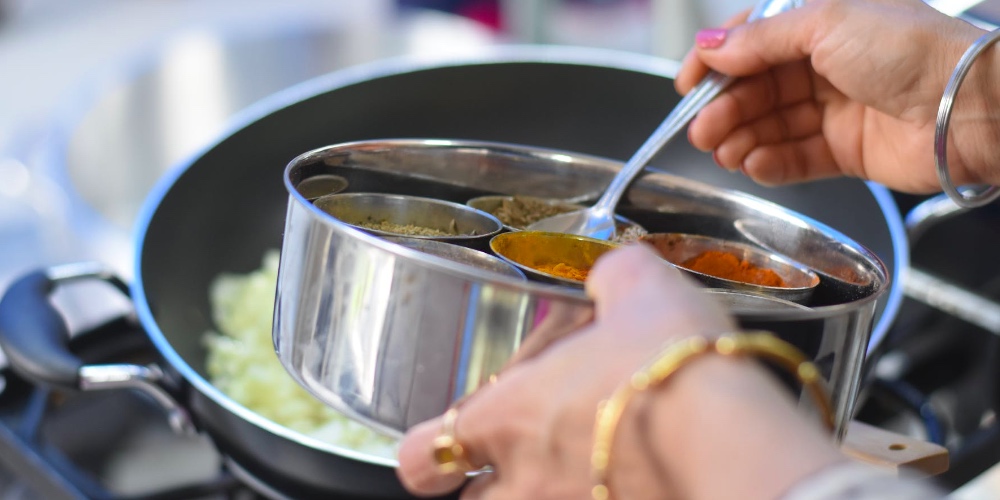Ayurvedic Cooking – Easy, Healthy and Delicious
Ayurveda is a Sanskrit word meaning life science. It is a more than five thousand year old system of traditional natural medicine developed through millennia through observations, experiments and meditation. The teachings of Ayurveda can be considered as a kind of alternative medicine that are widely used in India to this day. It aims to prevent disease and prolong the life of the body.
Followers believe that Ayurvedic practices performed on a daily basis not only serve their health, but also help them to understand themselves and the world around us, so that they can be in harmony and balance with their environment. Ayurvedic philosophy is based on the fact that the mind (or consciousness) and the body (or physical mass) not only influence each other, but form an inseparable unity.
Ayurvedic recipes for Indian cuisine in light of this are not only delicious but also healthy. Proper use is said to also have a healing effect on the body. If you know which Ayurvedic body type you have, you can prepare healing meals with Ayurvedic cooking for every kitchen. If you don’t know which Ayurvedic body type you belong to, you can find out here.
The Basics of Ayurvedic Nutrition
According to Ayurveda, there are six basic tastes, which, if present to the same extent in our diet, can balance our dosha, as each taste carries the properties of an element.
The 6 basic flavors: sweet, salty, sour, pungent, bitter and astringent. If the doshas work well, we are healthy and balanced, however, this condition can be further supported by consuming all the tastes together. In case of illness, balancing flavors should be used to restore the overactive dosha.
Tastes can also be grouped according to their effect, which can be cooling or heating. The warming flavors invigorate the Pitta dosha so that the Vata and Kapha dosha can be balanced with it. In addition to the pungent taste, other warming flavors include salty and sour.
If we are looking for cooling flavors, consume sweet, bitter and astringent foods to counteract the functioning of Pitta dosha and thus strengthen the quality of Vata and Kapha.
The following table shows which flavors can be used to balance certain qualities, so we can easily find what’s right for us among Ayurvedic recipes.
|
Taste |
Dosha to be increased |
Balancing doshas |
|
Sweet |
Kapha |
Vata and Pitta |
|
Sour |
Pitta |
Vata |
|
Salty |
Pitta |
Vata |
|
Pungent |
Pitta and Vata |
Kapha |
|
Bitter |
Vata |
Pitta and Kapha |
|
Astringent |
Vata |
Pitta and Kapha |
Balancing Food According to the Doshas
Which foods should we eat or just avoid if the balance of any quality in our body is disturbed and how can we adjust our Ayurvedic cooking for every kitchen?
Food to Balance Pitta Quality
To counterbalance the Pitta dosha, cold or lukewarm, slightly salty and less spiced foods should be eaten, which are recommended to be made with butter instead of fat or oil.
It is recommended to consume a lot of legumes and seeds (nuts, sunflower seeds, pumpkin seeds) as these foods slow down digestion and reduce appetite. Dairy products such as yoghurt, sour cream, cheese and coffee should also be avoided. Among vegetables, onions, radishes, carrots, eggplants, spinach and tomatoes should be avoided. Unripe and very sweet summer fruits are not recommended.
However, barley, wheat, oats and white rice have a beneficial effect, but brown rice, millet, corn and rye are not good. Milk and butter are favorable dairy products and can therefore also be used as a fat for cooking.
Of the meats, all red meat should be avoided, together with seafood. Tofu and all other soy derivatives are recommended instead of meat. Among the spices that are beneficial in all foods: dill, mint, saffron, cardamom, cinnamon, coriander seeds.

Foods to Balance Kapha Quality
Excessive consumption of sugary and fatty foods can lead to an increase in Kapha quality. If Kapha predominates, it is recommended to eat fat-free foods, such as roasted and grilled hot foods. It can be great to consume a bitter salad as well as tonic and ginger tea to relieve thirst.
The recommended spices include turmeric, cumin seeds, ginger and chili. Too much salt should be avoided. For the most part, all fruits can be eaten raw, which are not very sweet. For sweetening, a little honey can be used instead of sugar. Cereals include millet, buckwheat, rye, corn and barley. Consumption of red meat and sea fish should be avoided.
Foods to Balance Vata Quality
The predominance of Vata quality can be balanced with warm milk, cream, butter, hot soups, slowly cooked, steamed foods. All kinds of sweet, oily and hot food have a beneficial effect. It is recommended to eat a lot of spicy foods – such as ginger or chili, which stimulates digestion.
Almost all vegetables can be eaten, preferably cooked with fat and warm. Of the fruits, sweet, juicy, ripe fruits are the best, but dried fruits can also be eaten. All dairy products can be consumed as well as lean meats and fish. Consume all spices only in moderation, except ginger, chili, coriander, parsley.
Ayurvedic cooking is suitable for every kitchen. The recipes can be adjusted to every country’s cuisine, just select the ingredients according to your dosha. A conscious lifestyle is simple and if you follow our beneficial suggestions long enough, your health will thank you.
For more news and posts about yoga and a healthy, conscious lifestyle follow us on Facebook.
 English
English magyar
magyar